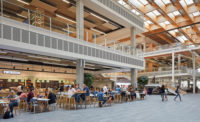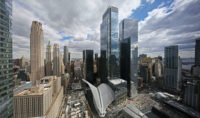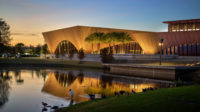Lisbon’s new riverside architectural icon, designed by London-based studio AL_A, opened last week to a flood of visitors.
After a construction period of two years and an investment of $22 million, the white-tiled, curvilinear kunsthalle, the second building of the new Museum of Art, Architecture and Technology (MAAT), opened its doors to the public on October 5, honoring the national holiday that signals the establishment of the Portuguese Republic.
Rising from the ground in an elegant curve, the design, for all its alluring contemporaneity, seems to naturally sprout out of the bank of the River Tagus, in Belém. According to Amanda Levete, founder of AL_A, and the project’s principal architect, by “blending structure into landscape, the kunsthalle is designed to allow people to walk over, under and through the building.”
Its most striking element, the facade’s 15,000 three-dimensional crackle-glazed tiles, at once reference the country’s longstanding ceramic craft tradition, capture the city’s changing light, and reflect the river’s water onto the museum’s main gallery.
The launch featured a 12-hour-long inaugural program that included the presentation of the kunsthalle’s first site-specific commission, Pynchon Park, a dystopian large-scale environment created by French artist Dominique Gonzalez-Foerster, as well as the opening of The World of Charles and Ray Eames in MAAT’s Central Tejo building, which opened in June 2016, and the inauguration of The Form of Form, the main exhibition of the 4th Lisbon Architecture Triennale.
Pynchon Park occupies the new building’s 12,700-square-foot Oval Gallery, one of the only interior spaces that is complete. The museum is set to be fully operational in March 2017, upon the conclusion of the remaining exhibition rooms, including the main gallery, and the video and project rooms, and a pedestrian bridge that will connect the city directly to the building’s rooftop public space.
The project was commissioned by the EDP Foundation—the not-for-profit branch of the Portuguese energy company—directly to AL_A in 2011. It is the main feature of MAAT, a 9.4-acre art campus that António Mexia, CEO of EDP Group and Chairman of thefoundation hopes “will restore the historic connection between the city and the water,” a connection severed by the construction of the riverside railway line that connects Lisbon to Cascais, at the end of the 19th Century.
Indeed, last week’s opening saw an unprecedented number of people visiting the once-neglected area, forcing authorities to close the pedestrian bridge above the railway, one of only two nearby points of connection between the city and the riverside.
In 2017, MAAT will also see the opening of a restaurant, shop, and a park designed by Lebanese studio Vladimir Djurovic Landscape Architecture.





















Post a comment to this article
Report Abusive Comment